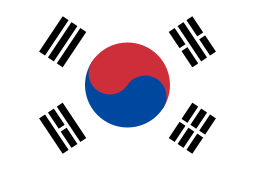 | |
| Taegeukgi, Taegukgi (Korean: 태극기, Hanja: 太極旗) | |
| Use | National flag and ensign |
|---|---|
| Proportion | 2:3 |
| Adopted | January 27, 1883 (original version, used by the Joseon dynasty) June 29, 1942 (during Japanese occupation, by the exiled Provisional Government of the Republic of Korea) July 12, 1948 (for South Korea, by the Constituent National Assembly) October 15, 1949 (current geometry) May 30, 2011 (current colors) |
| Design | A white field with a centered red and blue taegeuk surrounded by four trigrams |
| Designed by | Lee Eung-jun (Designed) Park Yung-hyo (Selected) Gojong (Approved) |
| Naval jack | |
 | |
| Use | Naval jack |
| Proportion | 2:3 |
| Design | A blue field with a white canton that has a red and blue taegeuk superimposed on two crossed anchors. |
| Governmental ensign | |
 | |
| Use | Government ensign |
| Proportion | 2:3 |
| Design | A white field with the logo of the government in the middle |
| Flag of South Korea | |
| Hangul | 태극기 |
|---|---|
| Hanja | 太極旗 |
| Revised Romanization | Taegeukgi |
| McCune–Reischauer | T'aegŭkki |
The national flag of the Republic of Korea, also known as the Taegeukgi (Korean: 태극기), has three parts: a white rectangular background, a red and blue taegeuk in its center, accompanied by four black trigrams, one in each corner. Flags similar to the current Taegeukgi were used as the national flag of Korea by the Joseon dynasty, the Korean Empire, as well as the Korean government-in-exile during Japanese rule. South Korea adopted Taegeukgi for its national flag in 1948.